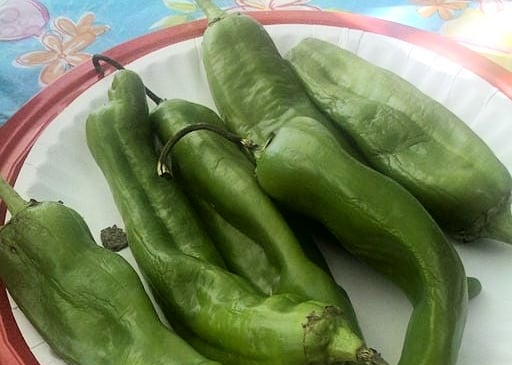Red, Green, or in Between?
/Eat out in New Mexico and you’re bound to hear it sooner or later: “Red or green?” That’s the state’s official shorthand for “what color chile would you like slathered on your burrito?” You can go the iconic route and ask for green, or get maximum kick by requesting both: “Christmas, please.”
Red, green, or in between, chile is New Mexico’s pride and joy. We’re talking about the Capsicum genus of flowering plants, which originated in South America but is now cultivated around the world for its flavorful fruits. Some call them “chilli peppers” (Britain), “capsicums” (Oceania), or “hot peppers” (elsewhere in the U.S.), but in New Mexico only one word will do: “chile.”
And it will do in all contexts, whether you’re discussing the root-to-tip plant, its fruit, or the spicy sauce atop your dinner. To wit:
- “Chile [the plant] is grown across the state, from Hatch in the south to Chimayó in the north.”
- “Green chile [the fruit] are harvested early in the growing season, while red chile are picked later.”
- “Roadside vendors roast the pods to make fresh chile [the sauce].”
- “I always carry an emergency shaker of chile [the dried powder] in my bag.”
(Oh, and don’t even bother bringing up chili—apparently that beef-and-bean stew is some kind of Texan thing.)
The people of South and Central America have cultivated various chile species for over five thousand years, but the Pueblo people living in present-day New Mexico didn’t grow them until conquistadors brought seeds north from Mexico in the 1580s. Hence “chile” with an e: the Aztecs called their cultivar “chilli,” which the Spanish rendered “chile” according to their spelling conventions. The spelling stuck, whether or not dictionaries (or members of Congress) agree.
In the four centuries since its arrival, chile has thoroughly flavored the cultural melting pot that is modern New Mexico. In the words of the New Mexico Chile Association, “Washington has its apples, Idaho its potatoes, Florida its oranges. New Mexico loves its chile.” And so does the rest of the nation: in 2013, readers of USA Today voted Albuquerque’s green chile (sauce) the best iconic American food.
Getting back to the original question—red or green—what’s the difference between the two?
Green Chile
It depends when you harvest the fruit: all pods start out green thanks to the presence of chlorophyll. If they’re harvested in this stage and promptly frozen or cooked, they’ll retain the green pigmentation. They’ll also be fairly tough-skinned, which is why they’re ubiquitously roasted, then generally cut and boiled into a spicy condiment—green chile.
Red Chile
On the other hand, if the chile are allowed to continue maturing on the plant they’ll eventually reach their final state: red. Just like deciduous trees come fall, chlorophyll eventually dissipates to unmask vivid pigments, in chile’s case capsanthin and capsorubin. Bonus: along the way pods’ sugar content increases, rendering the flesh softer and sweeter.
Although the green fruit will also turn red after they’ve been harvested, using shelf-ripened pods cheats you of red chile’s distinct taste: the chlorophyll fades to reveal the right color, but the mellow flavor can’t develop after the pod is plucked from the plant. Thus the most authentic red chile is left to ripen in the field so it can continue to draw substance from the soil as it matures.
Once it’s harvested red chile can be roasted, but because they’re so tender the window of time for doing so is small. Thus many are dried instead, often strung up in decorative ristras. Then the dried pods are ground into powder (commonly called paprika) or flakes (popular on pizzeria tables)... or rehydrated and boiled into a savory sauce—red chile.
So, red or green? One is made by roasting unripe fruit fresh off the plant, the other by stewing up dried-out pods, but if you trace them back to the plant they’re both the same chile, really. And they’re both richly flavored with a hint of heat—a chemical heat that we’ll explore next time. Get ready to spice things up!
This post was brought to you by New Mexico Chiles: History, Legend and Lore by Kelly Urig (a.k.a. the Chile Chica), Professor Ian Gravagne of Baylor University (though originally of Albuquerque), and some enchiladas served up Christmas style.

![A burrito adorned with green chile [the sauce]](https://images.squarespace-cdn.com/content/v1/56554c57e4b01110e1b44004/1452749300235-NYC1E1V3ESK3TJSAJFGC/Burrito+%28Stu+Spivack%2C+Wikimedia+Commons%29)




